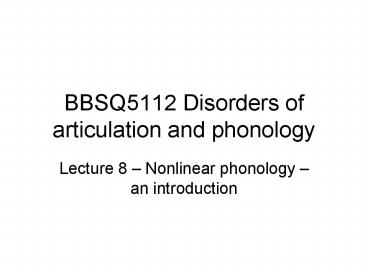BBSQ5112 Disorders of articulation and phonology - PowerPoint PPT Presentation
1 / 17
Title:
BBSQ5112 Disorders of articulation and phonology
Description:
Emphasizes the role of groupings of segments into syllables and feet ... Feet are always incorporated into higher level units prosodic words ... – PowerPoint PPT presentation
Number of Views:169
Avg rating:3.0/5.0
Title: BBSQ5112 Disorders of articulation and phonology
1
BBSQ5112 Disorders of articulation and phonology
- Lecture 8 Nonlinear phonology an introduction
2
Whats wrong with linear phonology?
- Sounds in a speech stream are related to each
other in more complex ways than just linearly
e.g. consonant harmony processes - All segments and all features are equally complex
and important, so theres no reason to suppose
that some more than others should be the targets
for deletion or substitution - We know that segments can be partially elided
(e.g. syllable weakening), so its not the case
that only whole segments are the locus of
deletion processes - Features do not behave as if they segments
3
So what shall we do about it?
- Come up with a theoretical framework which
- has something to say about the relations between
sounds in speech - does not assign any particular importance to
segments (over features) - Can account for the apparent independence of
features and segments
4
Nonlinear phonology
- Emphasizes the role of groupings of segments into
syllables and feet - Maintains that features are independent from each
other (nature and timing) - Seems to capture (describe and explain)
observations about childrens phonology more
precisely than earlier theories - Allows us to look at what is possible for the
child, and what is missing form the childs
system that needs to be there
5
Syllable and word structure
- Segments ? syllables
- Syllables ? feet
- Feet ? prosodic words
- Syllable smallest grouping of segments
- Syllable peak usually a vowel
- Consonants prior to the peak ONSET
- Consonants after the peak CODA
- Syllable with no coda OPEN
- Syllable with a coda CLOSED
- Peak Coda Rime
- Onset Rime Syllable (s)
6
s
rime
onset
peak
coda
s
t
I
7
Sonority hierarchy
- Vowels have highest sonority
- Then glide
- liquid
- nasal
- voiced fricative
- voiceless fricative
- voiced affricate
- voiceless affricate
- voiced stop
- voiceless stop
- Peak of syllable peak of sonority
- Sonority decreases hierarchically towards
syllable edges - Clump
- S-clusters violate sonority hierarchy
8
Intervocalic consonants
- If there is only one intervocalic consonant, it
is the onset of syllable 2, NOT the coda of
syllable 1 - If syllable 2 carries primary stress, the
intervocalic consonant is definitely the onset of
syllable 2 - If there is more than one intervocalic consonant,
place as many as possible in the second onset - /nVmb_at_ / /Vgli/
9
Child errors
- When children are making errors, they could
actually be making repairs fixing sound
sequences so that they are legal in their system
10
Feet and stress
- Some syllables are stressed (Strong), and others
are unstressed (weak) - A foot one stressed syllable, with or without
another unstressed syllable - A foot with stress on the first syllable
TROCHAIC (left-prominent, Sw) - A foot with stress on the second syllable
IAMBIC (right-prominent, wS)
11
Feet and stress
- Unstressed vowels schwa
- Unstressed vowels may not be diphthongal or too
long - The vowels /E/, /U/, /V/ never occur unstressed
12
Child constraints
- A target word might have too few syllables - e.g.
the child thinks all feet must have two syllables - up ? up_at_ ketchup ? k E tS _at_ p
- A target word might have too many syllables
e.g. two unstressed syllables - banana ? nana
- or the unstressed syllable might be in the
wrong place - balloon ? lun OR bVl_at_n
13
Prosodic words
- Feet are always incorporated into higher level
units prosodic words - A prosodic word containing two or more feet has
only one syllable with primary stress
14
Prosodic Word
Foot
Foot
s
s
s
s
S_at_n
neI
haI
b_at_
15
Child constraints
- Languages often have an upper bound on the length
of words one foot (two syllables) or two feet
(four syllables) - Children may have the same constraints
- Repair reduce long words to a single foot by
deleting a foot (one or more syllables) - hippopotamus ? pAm_at_s
- kangaroo ? kNg_at_
- protein ? poU
16
Prosodic Word
Foot
Foot
s
s
s
u
g_at_
kn
17
Prosodic Word
Foot
s
s
g_at_
kn































